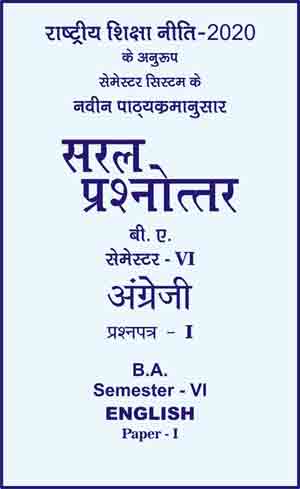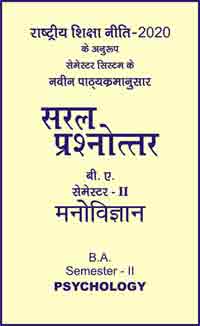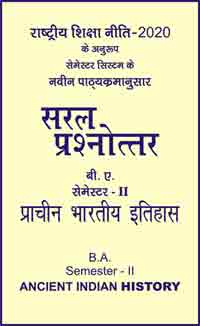|
बी ए - एम ए >> बीए सेमेस्टर 6 अंग्रेजी पेपर 1 बीए सेमेस्टर 6 अंग्रेजी पेपर 1सरल प्रश्नोत्तर समूह
|
5 पाठक हैं |
||||||
बीए सेमेस्टर 6 अंग्रेजी पेपर 1
Chapter 9 - Kamala Markandaya : Nectar in a Sieve
Objective Type Questions
For each of the following questions, four alternatives are given for the answer. Only one of them is correct. Choose the correct alternative.
-
Which novel by Kamala Markandaya established her international reputation?
(a) Nectar in a Sieve
(b) A Handful of Rice
(c) The Nowhere Man
(d) The Golden Cage -
Markandaya's novels primarily focus on which social and political issues?
(a) Post-colonial struggles
(b) Environmental concerns
(c) Gender equality
(d) All of the above -
Markandaya's writing style is characterized by:
(a) Lush imagery and lyrical prose
(b) Spare language and social commentary
(c) Experimental narrative techniques
(d) A blend of realism and magical realism -
Where was Kamala Markandaya born?
(a) Mumbai, India
(b) Mysore, India
(c) Chennai, India
(d) Kolkata, India -
When did Kamala Markandaya pass away?
(a) 1976
(b) 1982
(c) 2004
(d) 2007 -
In 'Nectar in a Sieve,' Rukmani's husband Natha is employed as:
(a) A farmer
(b) A rickshaw driver
(c) A factory worker
(d) A teacher -
The recurring motif of water in Markandaya's works symbolizes:
(a) Life and hope
(b) Destruction and displacement
(c) Both of the above
(d) None of the above -
Markandaya was actively involved in social and political activism, particularly focusing on:
(a) Women's rights
(b) Environmental protection
(c) Anti-colonial movements
(d) All of the above -
Which novel by Markandaya deals with the complex relationship between mothers and daughters?
(a) A Handful of Rice
(b) The Nowhere Man
(c) Two Virgins
(d) The Golden Cage -
Who is the author of "Nectar in a Sieve"?
(a) Arundhati Roy
(b) Salman Rushdie
(c) Kamala Markandaya
(d) Jhumpa Lahiri -
In which country is the novel primarily set?
(a) India
(b) Nigeria
(c) Sri Lanka
(d) Bangladesh -
What is the protagonist's name in the novel?
(a) Rukmani
(b) Sita
(c) Lakshmi
(d) Radha -
Where does Rukmani live at the beginning of the novel?
(a) In a bustling city
(b) In a rural village
(c) In a coastal town
(d) In a mountainous region -
What is Rukmani's primary occupation?
(a) Teacher
(b) Farmer
(c) Weaver
(d) Doctor -
Who is Rukmani's husband?
(a) Nathan
(b) Murugan
(c) Arjun
(d) Ira -
What challenges do Rukmani and Nathan face in their marriage?
(a) Infertility
(b) Wealth and luxury
(c) Lack of education
(d) Political conflicts -
What is the significance of the title "Nectar in a Sieve"?
(a) A symbol of abundance
(b) A metaphor for life's hardships
(c) A representation of wealth
(d) A religious artifact -
Who is Kunthi in the novel?
(a) Rukmani's sister
(b) Rukmani's daughter
(c) A wealthy landowner
(d) A village healer -
What is the impact of industrialization on the characters in the novel?
(a) Increased prosperity
(b) Environmental degradation
(c) Improved healthcare
(d) Political stability -
What role does Kenny, the doctor, play in the novel?
(a) He is Rukmani's son
(b) He is a political leader
(c) He provides healthcare to the villagers
(d) He is a rival farmer -
What major event occurs in the village that impacts Rukmani's family?
(a) Flood
(b) Drought
(c) Earthquake
(d) War -
How does the novel depict the relationship between humans and the natural world?
(a) Harmony and balance
(b) Exploitation and destruction
(c) Indifference and neglect
(d) Symbiosis and cooperation -
What is the fate of Rukmani's sons in the novel?
(a) They become successful farmers
(b) They join the military
(c) They die tragically
(d) They become political leaders -
Who represents the changing face of India in the novel?
(a) Old Granny
(b) Nathan
(c) Kenny
(d) Kunthi -
How does the novel address the theme of resilience in the face of adversity?
(a) Through political activism
(b) Through religious rituals
(c) Through the characters' endurance
(d) Through technological innovations -
What is the significance of the tamarind tree in the novel?
(a) It is a symbol of fertility
(b) It is a place of worship
(c) It provides shade and sustenance
(d) It is a source of conflict -
How does the novel conclude?
(a) With a joyful celebration
(b) With a tragic event
(c) With the characters achieving their dreams
(d) With a journey into the unknown -
In what ways does "Nectar in a Sieve" comment on the impact of modernization on traditional ways of life?
(a) Celebrating progress and development
(b) Resisting change and modernization
(c) Embracing technology and innovation
(d) Ignoring the challenges of modernization -
Who is Irawaddy in "Nectar in a Sieve"?
(a) Rukmani's daughter
(b) Rukmani's sister
(c) The village chief
(d) Nathan's friend -
What crop does Nathan primarily cultivate on his land?
(a) Rice
(b) Wheat
(c) Sugarcane
(d) Cotton -
How does Rukmani feel about her daughter marrying a tannery worker?
(a) She is ecstatic
(b) She is disappointed
(c) She is indifferent
(d) She is relieved -
What is the name of Rukmani's best friend in the village?
(a) Janaki
(b) Kunthi
(c) Ira
(d) Ammu -
Who is Sacrabani in the novel?
(a) A village leader
(b) A religious figure
(c) A government official
(d) Rukmani's grandson -
What major change occurs in Rukmani's life due to the construction of a new road?
(a) Increased trade opportunities
(b) Improved healthcare
(c) Increased isolation
(d) Government subsidies -
How does Rukmani and Nathan's relationship change over the course of the novel?
(a) They grow closer
(b) They become estranged
(c) They separate
(d) They both die tragically -
What role does the character Biswas play in the novel?
(a) Landlord
(b) Educator
(c) Money lender
(d) Political leader -
In what ways does the novel address the impact of colonialism on rural communities?
(a) Economic exploitation
(b) Cultural enrichment
(c) Political empowerment
(d) Technological advancements -
Who is the narrator of the story?
(a) Rukmani
(b) Irawaddy
(c) Nathan
(d) Kenny -
How does Rukmani and Nathan's family react to the arrival of a stranger in the village?
(a) With hospitality
(b) With suspicion
(c) With fear
(d) With indifference -
What tragedy befalls the village, leading to increased poverty and suffering?
(a) Drought
(b) Flood
(c) Epidemic
(d) War -
How does the novel depict the impact of gender roles on the characters' lives?
(a) Upholding traditional gender roles
(b) Challenging gender norms
(c) Ignoring gender issues
(d) Emphasizing patriarchal values -
Who does Rukmani turn to for support when facing challenges in her life?
(a) Kenny
(b) Janaki
(c) Biswas
(d) Ira -
What is the significance of the tannery in the novel?
(a) It symbolizes progress
(b) It represents environmental degradation
(c) It is a place of worship
(d) It is a symbol of resistance -
How does Rukmani cope with the loss of her sons and the challenges she faces?
(a) Through religion
(b) Through education
(c) Through political activism
(d) Through technological innovations -
What is the role of the character Old Granny in the novel?
(a) Mentor and guide
(b) Antagonist
(c) Religious leader
(d) Political activist -
How does the novel conclude?
(a) With a joyful celebration
(b) With a tragic event
(c) With the characters achieving their dreams
(d) With a journey into the unknown -
What is the original name of Kamala Markandaya?
(a) Kamala Das
(b) Kamala Maria
(c) Kamala Purnaiya
(d) None of these -
What was her initial Profession?
(a) Journalism
(b) Administration
(c) Teaching
(d) Painting -
What is the name of her husband?
(a) William
(b) John Taylor
(c) Clinton
(d) Coleridge -
In which year 'Nectar in a Sieve' was published?
(a) 1951
(b) 1953
(c) 1952
(d) 1954 -
Kamala Markandaya was born in -
(a) 23rd June, 1924
(b) 2nd January, 1924
(c) 5th February, 1924
(d) 4th January, 1923 -
Kamala Markandaya married with -
(a) Bertrand Taylor
(b) William Taylor
(c) T.S. Eliot
(d) S.T. Coleridge -
Kamala Markandaya was died on ?
(a) 16 May, 2004
(b) 16 June, 2004
(c) 20 May, 2004
(d) None of these -
When did Kamala Markandaya write 'Nectar in a Sieve'?
(a) 1952
(b) 1950
(c) 1954
(d) 1951
|
|||||













